 |
Glossary |
 |
Activity |
| |
 |
Fish Processing Techniques |
|
First Nations Fish Processing Techniques
Coast Salish woman cleaning
salmon.
© RBCM pn6025
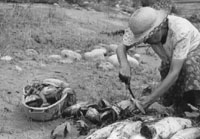
|
First Nations peoples on the BC coast advanced the preservation of fish to a fine art. By
drying or smoking the fish, First Nations people were able to
store enough food to last them through the winter. Groups even had enough left over to host large
feasts, or potlatches. No part of the fish was wasted. For instance,
the Lekwiltok, of the Campbell River area, preserved or ate every edible piece of the salmon
including the head, eggs, tail, oil, and bones. The salmon eggs were seen as a
delicacy by many.
Salmon being cut into flaps in
preparation for scoring the flesh.© RBCM pn6015
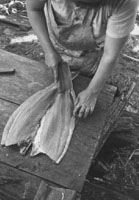
|
Salmon could also be roasted, boiled, or steamed before eating. There were many ways to
butcher and preserve fish. Pieces of salmon could be placed on stakes around the fire in order to
roast them, and were often eaten as snacks. Alternatively, salmon could be boiled and steamed in
bentwood boxes or open pits. Stones would be heated in the fire, washed off, and then placed in a
wooden box containing water. When the water was boiling, the fish (and possibly flavouring)
would be added, and a woven mat would be placed over top to keep the steam in. Often, various
plants and berries were used to spice up the taste of the fish when cooking or drying it.
Salmon flesh has been scored in
preparation for roasting.
© RBCM pn6014
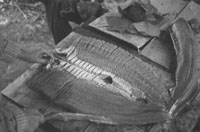
|
Smoking or drying was the most common way of processing salmon. Salmon could be dried
by wind, the sun's rays, or in smokehouses. Certain tasks had to
be done to prepare the salmon for drying. For instance, the salmon was often soaked for a day
before removing the meaty parts which were then cut up into strips to be dried. If the salmon was
to be smoked, which gave it a nice flavour, then it would be hung on poles and racks inside a
smoke house for 2 to 4 days, depending on the desired taste.
Scored Salmon flank drying in
cache.© RBCM pn6018
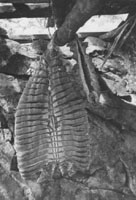
|
Salmon was processed at fish camps during the summer or fall months. The men would catch
the salmon using various fishing techniques, and the women would cook it and get it ready for
winter. Women were in charge of butchering, hanging the fish to dry, tending the drying racks,
regulating the fires in the smokehouses, cooking the fish, and any other tasks related to the
processing of fish. Curing fish took skill and know-how to get the
desired taste, and to guard against spoiling. Mothers taught their daughters the finer skills of
processing. Every step in the process had to be done just right before storing the salmon in
containers for the winter.
Prepared Salmon pieces roasting
on stakes by fire. © RBCM pn7806-36
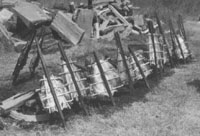
|
The species of salmon, the season it was caught in, the different climates on the coast, and
local traditions all had an impact on how the salmon was prepared. Often, different First Nations
groups would specialize in a certain type of processing, and would then trade with other groups
to obtain variations or foods that they did not have. For instance, eulachon oil was often acquired through trade with the Nisga'a of the
Nass River or other First Nations groups that had access to this fish. Eulachon oil was an
important part of First Nations peoples' diet. It supplemented their diet with necessary oil that
was lost from the salmon during the drying process, and gave smoked salmon added flavour.
First Nations peoples' ability to trade for and process enough food to last them through the winter
allowed them to grow and prosper on the coast of British Columbia.
Click on the image for a larger and more detailed version. You can use your
back button to bring you back to this page.
Top of page.
|



